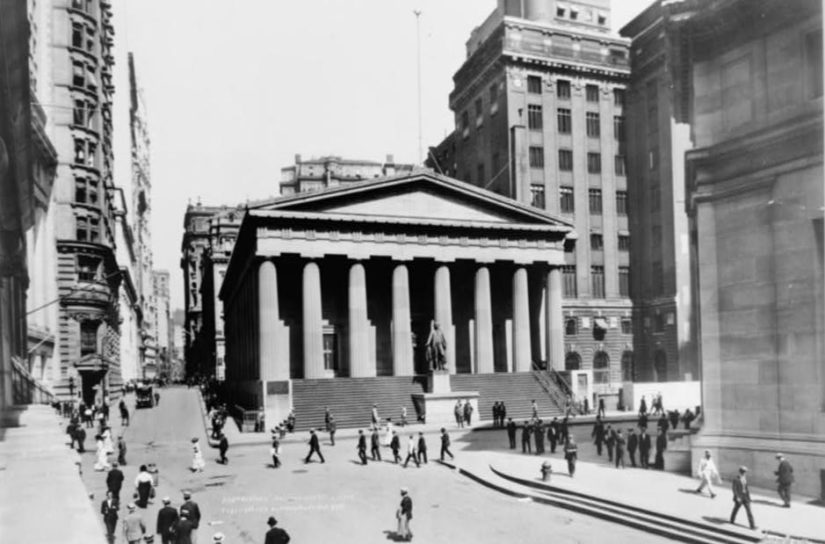
Gardner Osborn
During the Great Depression, Gardner Osborn advocated to save many historic buildings in lower Manhattan such as Federal Memorial Hall.
Gardner Osborn, a historian and preservationist, was born in New Haven, Connecticut, in 1893. He attended Yale University and graduated in 1915. After graduation, Osborn moved to New York City where he began working for the J. Walter Thompson Advertising Agency. He later worked as the publicity director for Bloomingdale’s, and then went on to do public relations for the Downtown Owners Committee.1
Gardner Osborn was active in many civic groups over the course of his life. He served as executive director of Federal Hall Memorial Associates (1940-1968), vice president of the Bill of Rights Commemorative Society, secretary general of the Order of the Founders and Patriots of America, vice president of the United States Flag Foundation, and as president of the New York Chapter of the Sons of the American Revolution.2 He was also involved with the Municipal Art Society and the American Scenic and Historic Preservation Society.
He died on July 4, 1979, at the age of 86.3
As a historian and preservationist, Gardner Osborn participated in many campaigns to save historically significant structures in New York. Osborn’s leadership helped advance the level of interest and excitement surrounding the subject of preservation.4
Beginning in the early days of the Great Depression, Osborn led a struggle to ensure that the historically significant structures of New York City would be saved. Osborn specifically valued the historic past of Lower Manhattan, which functioned as the seat of the nation’s government for years.5
Osborn led the successful campaign to save Federal Memorial Hall, located in downtown Manhattan, in the 1930s. The 1939 World’s Fair was dedicated to the date of George Washington’s inauguration, which took place in Federal Memorial Hall. This building formerly housed the Subtreasury. Before Federal Memorial Hall was built, the Old City Hall Building stood in that same location. Through Osborn’s efforts, Federal Memorial Hall was renovated and declared a landmark in 1939.6
As secretary of the American Scenic and Historic Preservation Society, Osborn participated in the battle against Robert Moses's plan to construct a Brooklyn Battery Bridge. Osborn recognized that the construction of the Brooklyn-Battery Tunnel was inevitably going to destroy the aesthetic character of the historic houses on lower Greenwich Street. He thus focused on efforts to preserve this area on film. He documented the area known as the Syrian Quarter, a cluster of historic structures between State and Washington Streets, many of which dated back to the era between 1800 and 1830. Photographs were taken and researchers documented family histories of the occupants back to the year 1830. Osborn’s research was subsequently donated to the Library of Congress.7
In May of 1941, three months after Robert Moses announced his plan to demolish Castle Clinton, the American Scenic and Historic Preservation Society (ASHPS) and the New-York Historical Society jointly called a meeting to discuss "The preservation of Historic Sites and Buildings in the City of New York." Buildings under discussion were the Schenck House in Highland Park, Brooklyn; the New York Aquarium (aka Castle Clinton) in Battery Park; and other historic properties that were owned by the City of New York, and under the control of the Parks Department Commissioner Robert Moses. As a representative of the ASPHS, Osborn attended this important meeting along with Ely Jacques Kahn, George McAneny, and Albert S. Bard. The individuals present at the meeting created a committee "to ensure immediate and effective protest should any landmark be threatened, and to organize cooperative efforts for its preservation." The committee was also charged to "consider setting up a permanent board to act on such questions in the future.”8
By October 1, 1941, the New York Aquarium was closed, and the demolition of Castle Clinton seemed imminent. That same month, the Municipal Art Society established an "'active committee' for the purpose of endeavoring to protect and preserve New York’s remaining historic buildings as well as areas with the architectural charm of the past.”9 Osborn served on this committee, along with preservationists Talbot F. Hamlin (unofficially serving) and Professor Carl Feiss. Employing his knack for documentation, Osborn was the member of the "active committee" who reported at the Municipal Art Society’s board meetings.10
During the 1950s and '60s, Osborn was a major player within the American Scenic and Historic Preservation Society. During these years, the ASHPS took control of several historic sites around New York, including Grant’s Tomb, Alexander Hamilton’s House, and the birthplace of Theodore Roosevelt.11
- Municipal Art Society Records
Archives of American Art
1285 Avenue of the Americas, Lobby Level
New York, NY 10019
Tel: (212) 399-5015
Fax: (212) 307-4501
- Alfred E. Clark, “Gardner Osborn, Preservationist, 86,” The New York Times, 8 July 1979.
- Ibid.
- ”Obituary,” New York Times, 8 July 1979.
- Anthony C. Wood, Preserving New York: Winning the Right to Protect A City’s Landmarks (New York: Routledge, 2008), page 65.
- Alfred E. Clark, “Gardner Osborn, Preservationist, 86,” The New York Times, 8 July 1979.
- Ibid.
- Gregory F. Gilmartin, Shaping the City: New York and the Municipal Art Society (New York: Clarkson Potter, 1994), page 344.
- ”For Preservation,” New York Historical Quarterly Bulletin, Vol. 25, No. 3. (July 1941) in Anthony C. Wood, Preserving New York: Winning the Right to Protect A City’s Landmarks (New York: Routledge, 2008), page 62.
- Municipal Art Society Board Meeting Minutes, 22 October 1941, Municipal Art Society of New York Records, the Archives of American Art.
- Anthony C. Wood, Preserving New York: Winning the Right to Protect A City’s Landmarks (New York: Routledge, 2008), page 65.
- Alfred E. Clark, “Gardner Osborn, Preservationist, 86,” The New York Times, 8 July 1979.